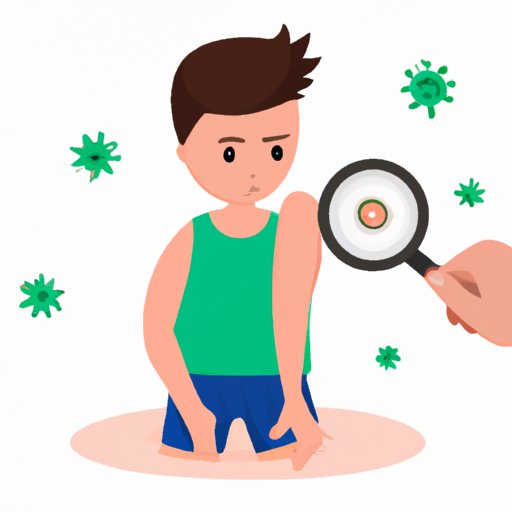
I. Introduction
Fungal infections are common ailments affecting millions of people worldwide. Fungi are microscopic organisms that can thrive in different environments, including the human body. While some fungi are harmless, others can cause infections that range from mild to severe, depending on the individual’s immune system and the type of fungi responsible for the infection. Understanding the causes and risk factors for fungal infections, as well as the symptoms, prevention techniques, and treatment options, is critical in managing this health condition.
II. Causes of Fungal Infections: Identifying the Causes and Risk Factors
Fungi are responsible for causing various infections in humans, ranging from skin infections to systemic infections. Some common types of fungi that can cause infections include dermatophytes, yeasts, and molds. Fungal infections are typically spread through contact with infected individuals, contaminated surfaces, or contaminated soil or water. People who have weakened immune systems due to illnesses such as HIV/AIDS, diabetes, or cancer, or those who take immunosuppressive drugs, are more likely to develop fungal infections. Other risk factors include excessive sweating, poor hygiene, and exposure to hot or humid environments.
III. Understanding Fungal Infections: The Biology and Symptoms of Fungal Infections
Fungi grow and thrive in warm, moist environments. When they overgrow, they can cause infections in different parts of the body. Some common symptoms of fungal infections include itching, redness, and irritation of the affected area. Other signs and symptoms may include flaking or cracking of the skin, scaling, or blisters. Fungal infections can occur on the skin, nails, hair, or internal organs such as the lungs or mucous membranes. Common types of fungal infections include athlete’s foot, ringworm, thrush, and candidiasis.
IV. Prevention of Fungal Infections: Tips and Techniques to Avoid Fungal Infections
Preventing fungal infections requires a proactive approach that involves consistent personal hygiene habits. Some ways to prevent fungal infections include keeping the skin clean and dry, avoiding sharing personal items such as towels or razors, wearing shoes or sandals in communal areas such as gyms or swimming pools, and avoiding tight-fitting clothes or shoes. Maintaining a healthy lifestyle, including consuming a balanced diet rich in nutrients and probiotics, managing stress levels, and practicing good sleep hygiene, can also help boost the immune system and reduce the risk of fungal infections.

V. Fungal Infections in Different Body Parts: A Comprehensive Guide to Understanding Fungal Infections
The symptoms and treatment options for fungal infections vary depending on the body part affected. Some common types of fungal infections include:
- Skin Infections: Tinea corporis or ringworm is a common fungal infection that affects the skin. Symptoms include a circular rash that appears red and scaly.
- Nail Infections: Onychomycosis, commonly known as toenail fungus, is a fungal infection that affects the nails. Symptoms include thickening and discoloration of the nail, as well as a foul smell.
- Hair Infections: Tinea capitis is a fungal infection that affects the scalp and hair. Symptoms include itching, scaling, and hair loss in some cases.
- Oral Infections: Thrush is a common fungal infection that affects the mouth and throat. Symptoms include white patches on the tongue, cheeks, or throat, as well as pain or discomfort when swallowing.
- Systemic Infections: Systemic fungal infections affect internal organs and can be life-threatening if left untreated. Some common types include cryptococcal meningitis, histoplasmosis, and candidiasis. Symptoms include fever, chills, body aches, and other flu-like symptoms.
Early diagnosis and prompt treatment are essential in managing fungal infections.
VI. When and How to Seek Medical Help for Fungal Infections: Understanding the Treatment Process
Minor fungal infections can often be treated with over-the-counter antifungal creams or ointments. However, more severe infections may require prescription medications, such as oral antifungal medications or antifungal injections. It is important to follow the right treatment plan and complete the course of medication as prescribed to avoid recurring infections and the development of drug-resistant strains of fungi. If symptoms persist or worsen, it is essential to seek medical help promptly, as untreated fungal infections can result in serious complications.
VII. Common Myths About Fungal Infections: Exploring Misconceptions and Facts About Fungal Infections
There are many misconceptions about fungal infections, which can lead to delays in diagnosis and treatment. Some common myths include:
- Myth #1: Fungal infections are not serious medical conditions. – Fact: Fungal infections can cause significant discomfort, affect quality of life, and lead to complications if left untreated.
- Myth #2: Fungal infections only affect people with poor hygiene. – Fact: While poor hygiene can increase the risk of fungal infections, it is not the only factor that plays a role. Anyone can develop a fungal infection, regardless of their hygiene habits.
- Myth #3: Over-the-counter creams and ointments are always effective in treating fungal infections. – Fact: While some mild fungal infections can be treated with over-the-counter medications, more severe infections may require prescription-strength medications.
- Myth #4: Once treated, fungal infections can never return. – Fact: Fungal infections can recur, especially if the underlying risk factors are not addressed or if the treatment process is incomplete.
VIII. Conclusion
Fungal infections are common health conditions that can affect people of all ages and genders. Understanding the causes, risk factors, symptoms, prevention techniques, and treatment options can help individuals manage fungal infections effectively. By adopting good hygiene habits, leading a healthy lifestyle, seeking medical help promptly when needed, and staying informed about the facts and realities of fungal infections, individuals can reduce their risk of developing fungal infections and achieve better health outcomes in the long run.




